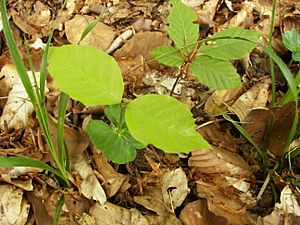Plant morphology facts for kids

Plant morphology (say: mor-FOLL-oh-jee) is the study of the outside parts and shapes of plants. It looks at things like how leaves are shaped, how flowers are arranged, or what roots look like. It's different from plant anatomy, which studies the tiny, inside parts of plants, often using a microscope. Knowing about plant morphology helps us identify different plants just by looking at them!
Contents
What is Plant Morphology?
Plant morphology is all about understanding the different shapes and forms that plants take. It helps us see how plants are built and how their parts work together. For example, it studies why some leaves are wide and flat, while others are long and thin. This field of science helps us tell one plant from another.
External Plant Parts
Scientists who study plant morphology look at many different parts of a plant. These include:
- Roots: These are usually underground. They hold the plant in place and soak up water and nutrients. Roots can be thick like a carrot or spread out like a net.
- Stems: Stems grow above the ground. They support the leaves, flowers, and fruits. Stems can be strong and woody like a tree trunk, or soft and green like a flower stem.
- Leaves: Leaves are usually green and flat. They are like the plant's food factories, using sunlight to make energy. Leaves come in many shapes, sizes, and patterns.
- Flowers: Flowers are often colorful and fragrant. They are the parts of the plant that help it make seeds for new plants.
- Fruits: Fruits grow from flowers and hold the seeds. They can be juicy like an apple or dry like a nut.
- Seeds: Seeds contain a tiny new plant ready to grow. They are protected by the fruit.
Morphology vs. Anatomy
It's easy to mix up plant morphology and plant anatomy, but they study different things.
- Plant morphology looks at the outside of the plant. It's like looking at a person and seeing their hair color, height, or how their arms and legs are shaped.
- Plant anatomy looks at the inside of the plant. It's like looking at a person's bones, muscles, or organs using X-rays or a microscope. Plant anatomy studies tiny cells and tissues.
Both are important for understanding how plants live and grow!
Why is Plant Morphology Important?
Studying plant morphology is very useful for many reasons:
- Identifying Plants: It helps us recognize different plants. If you know what a maple leaf looks like, you can spot a maple tree. This is helpful for gardeners, farmers, and even just when you're exploring nature.
- Classifying Plants: Scientists use plant shapes to group plants together. Plants with similar forms often belong to the same family. This helps us understand how different plants are related.
- Understanding Growth: By studying morphology, we learn how plants grow and develop over time. We can see how a tiny seed grows into a big tree or how a flower changes into a fruit.
- Agriculture and Farming: Farmers use this knowledge to grow healthier crops. They can choose plants with shapes that are good for harvesting or that resist diseases better.
- Plant Adaptation: Morphology helps us understand how plants adapt to their environment. For example, desert plants often have thick, waxy leaves to save water, which is a morphological adaptation.
Images for kids
-
Inflorescences emerging from protective coverings
-
Asclepias syriaca showing complex morphology of the flowers.
-
Looking up into the branch structure of a Pinus sylvestris tree
See also
 In Spanish: Morfología vegetal para niños
In Spanish: Morfología vegetal para niños





